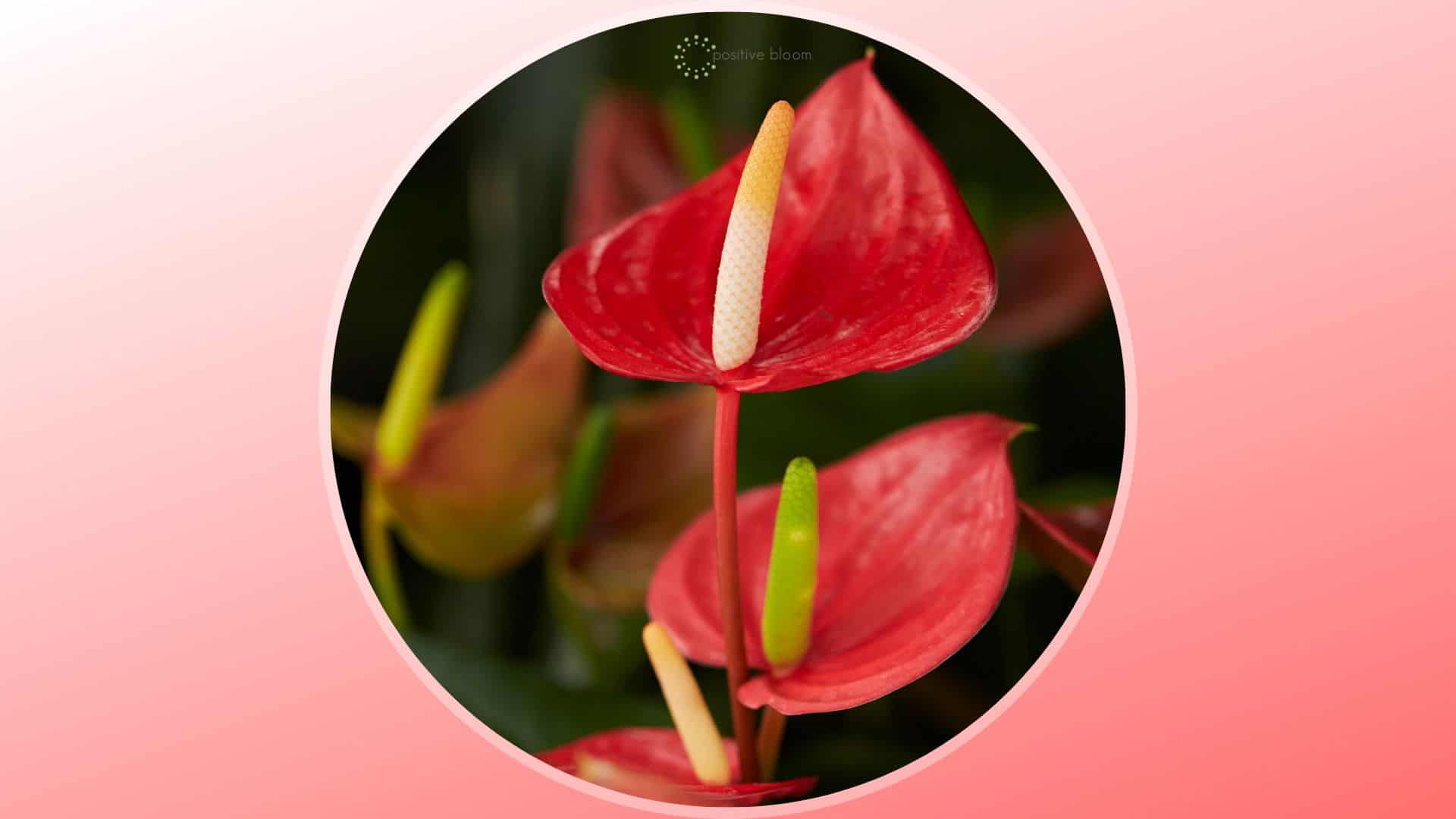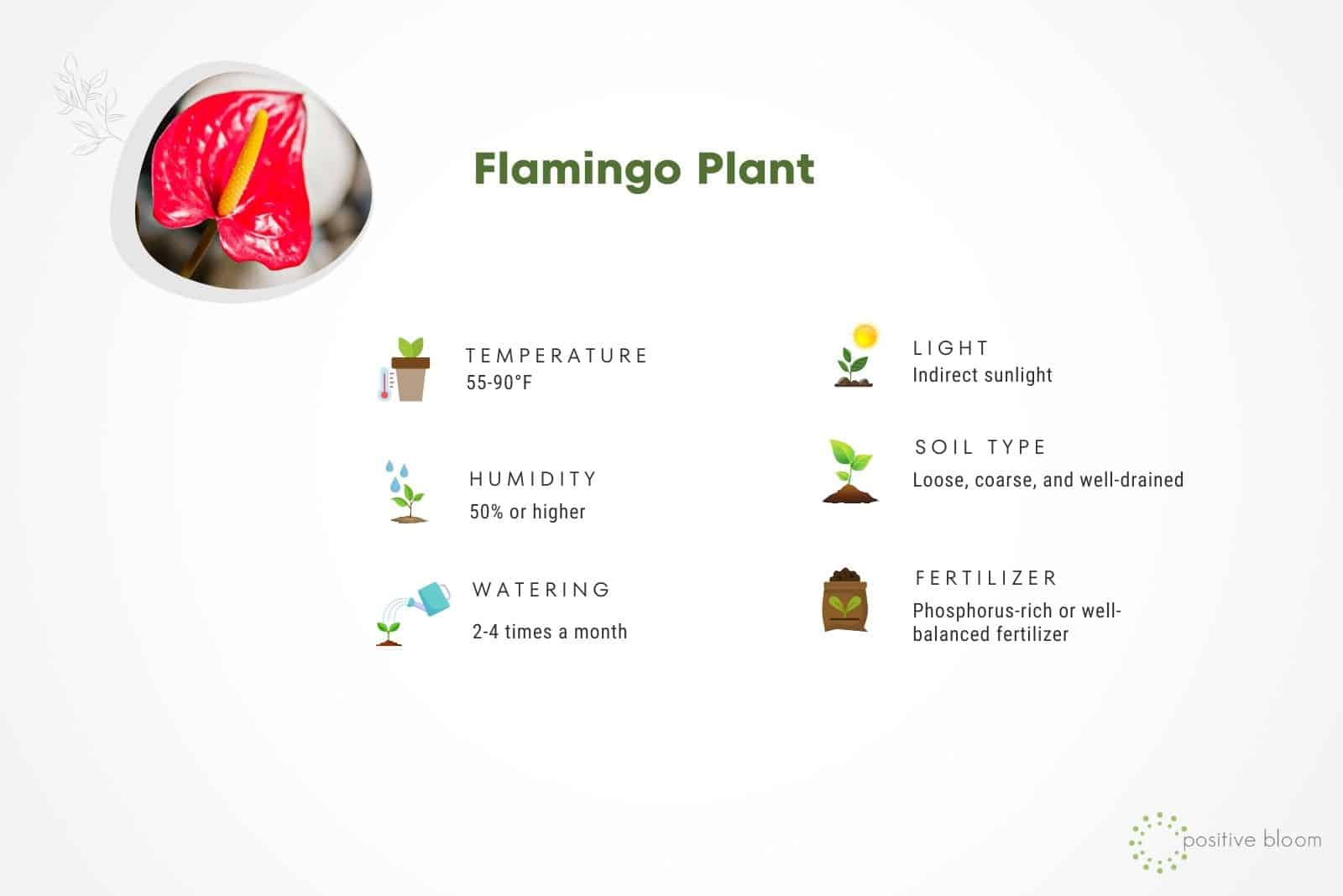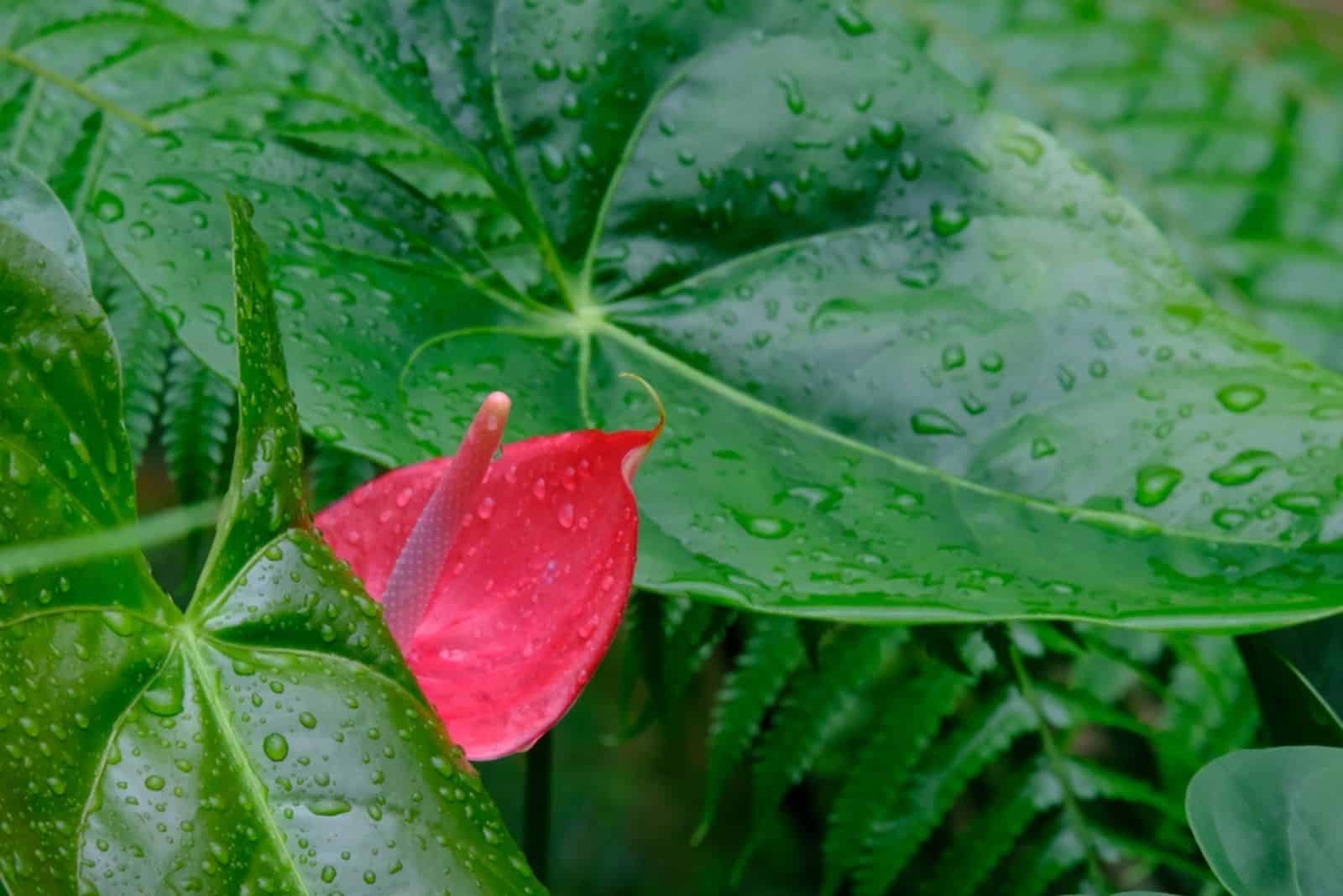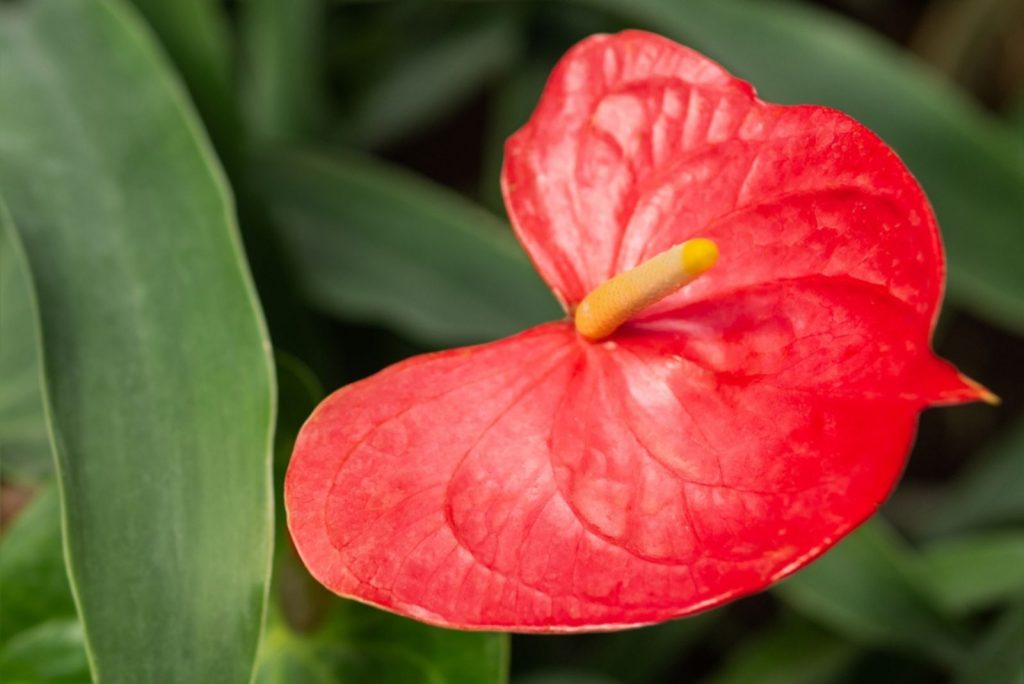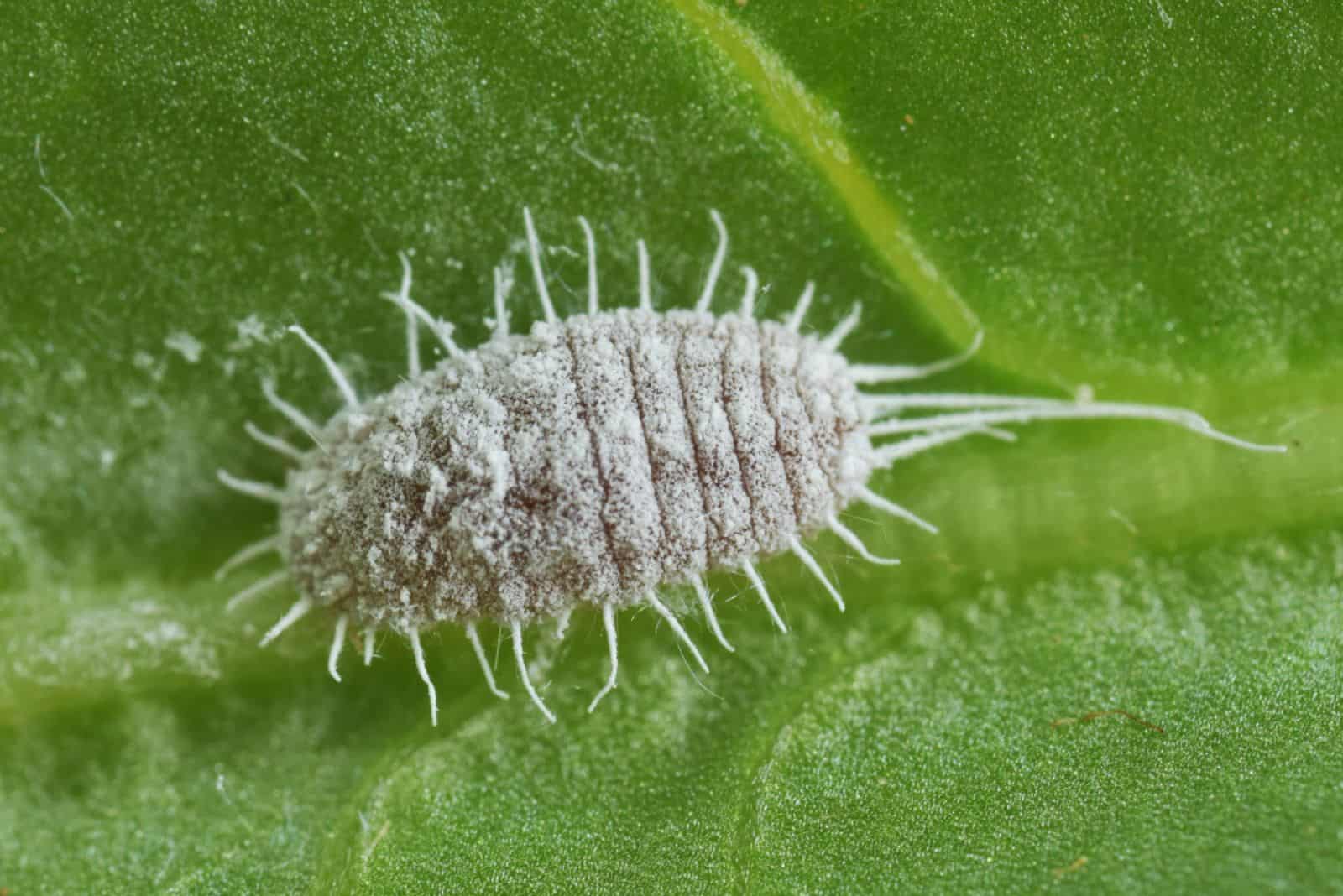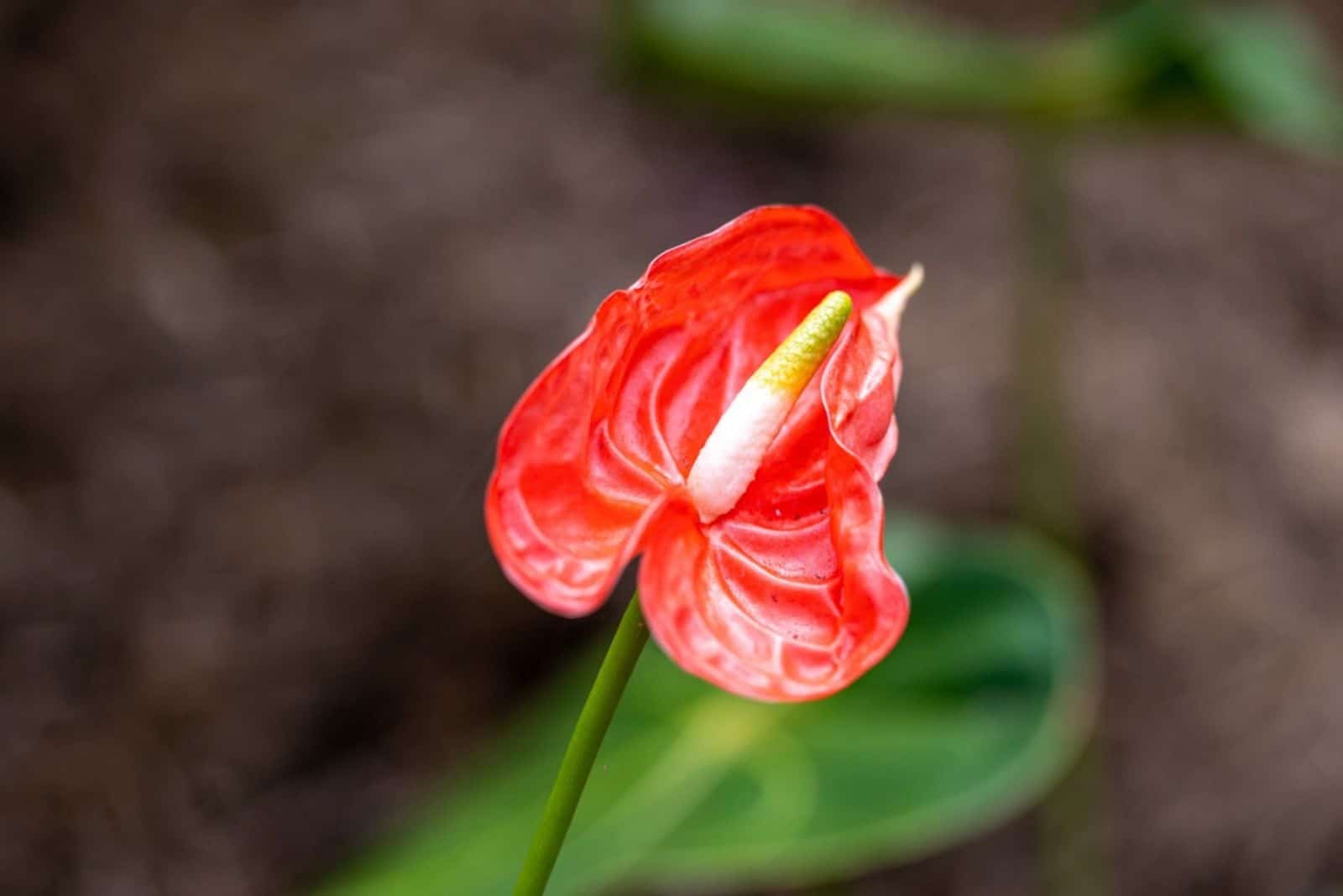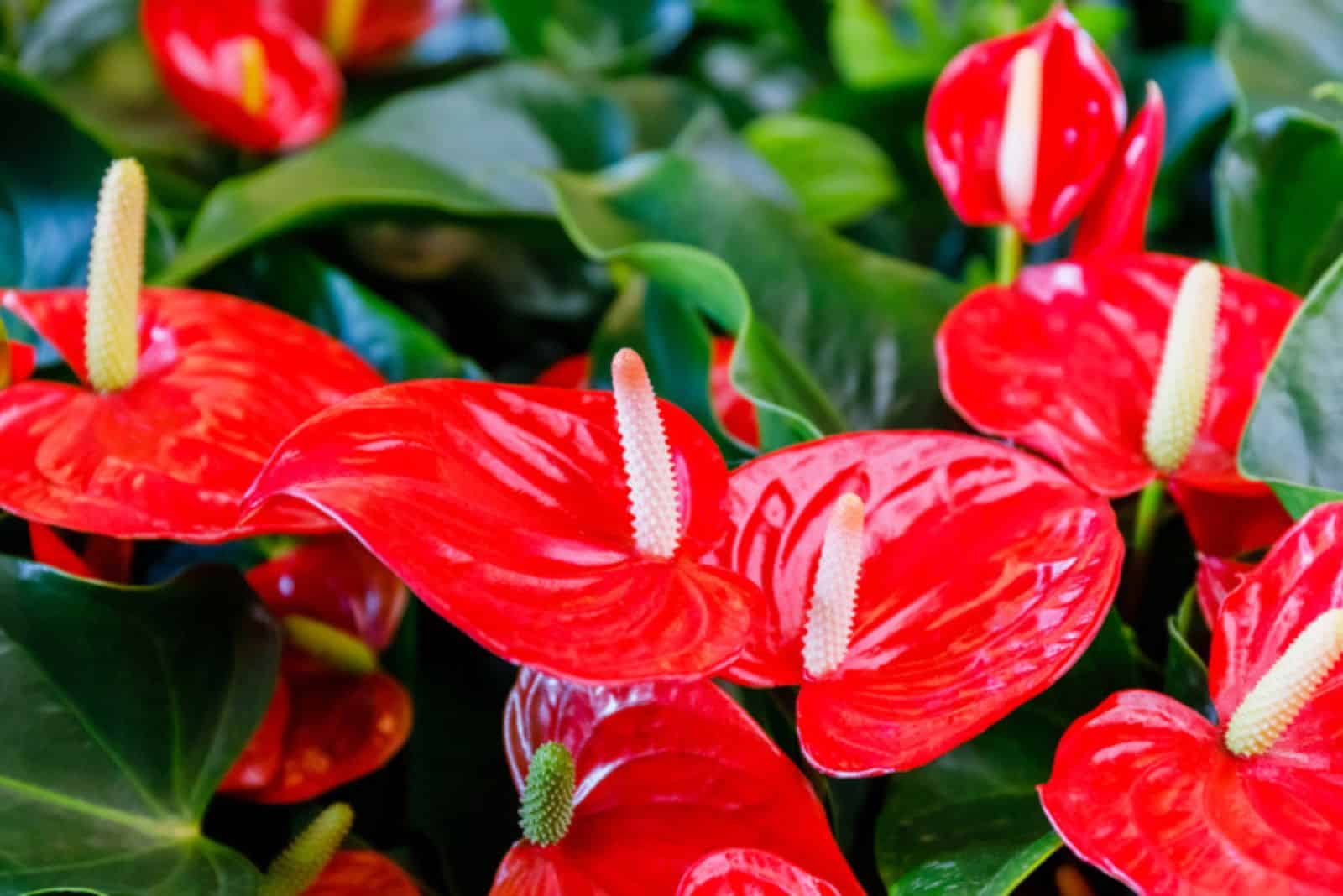The flamingo plant, or anthurium as we more commonly call it, is a plant that comes from the tropical regions of America.
This genus has so much to offer, from gorgeous green leaves to bright red, glossy “flowers”.
And the best thing about it is that you can grow most of the species as houseplants.
Therefore, we will discuss everything you need to know about caring for laceleaf plants (anthuriums) and dealing with their common issues.
We’ll also include some interesting facts about this plant at the end of the article, such as their appearance and toxicity, and present some popular types you won’t be able to resist.
Before we get there, let’s learn some specifics about these plants:
[table id=640 /]
Flamingo Plant Care Guide
The best thing about the anthurium is how easy it is to care for. Expose it to bright indirect light, water it once the top portion of the potting mix is dry, keep it in high humidity, and fertilize it every once in a while, and it’ll thrive!
You should consider repotting it once you notice its roots coming out of the drainage holes, and prune unsightly foliage, but you don’t have to do it very often.
Of course, these are just the basics, and we’ll discuss them in more detail in the following sections.
Light Requirements
The light requirements for anthuriums are fairly straightforward; expose your plant to indirect light and keep it away from direct sunlight.
Too much light, especially during midday, can burn your laceleaf’s beautiful foliage, which is why you shouldn’t keep these plants on west-facing windows lit with midday sun rays.
Instead, place your flamingo plant on an east or south-facing window, where the direct sunlight it gets in the morning or evening isn’t as harsh and won’t cause any damage to the foliage.
You can also keep this plant outside during the warm season, just make sure to protect it from the midday sun.
And if your home doesn’t get enough light and you don’t feel like risking sunburn outside, you can just use grow lamps for plants. Place your anthurium at least 12 inches away from it, and it’ll thrive.
Water And Humidity
Anthuriums are tropical plants, but that doesn’t mean you should drench them in water every day. Instead, you should irrigate them only when the top part of the potting soil dries out.
This means that you can water them about once a week during their growing season, and approximately every other week during dormancy.
Of course, if you have very loose soil that dries out fast and you keep this plant in a warm and sunny location, you will have to irrigate it more frequently.
However, touching the soil will help you decide when to add more moisture and when the plant’s had enough.
Some growers advise placing ice cubes on top of the soil and letting them melt to hydrate your plant without the risk of overwatering or root rot. That sounds like a great idea, but ice water is too cold for warmth-loving flamingo plants, which is why you shouldn’t resort to this technique.
Always irrigate these plants with lukewarm water, and you’ll have no issues!
Finally, water the plant in the morning or late afternoon to ensure it gets enough moisture, but doesn’t stay waterlogged overnight.
Humidity
Anthuriums are native to tropical regions of Central and South America, so they thrive in high humidity environments.
Make sure that your indoor air moisture levels are at least 50% to prevent curling and browning of the leaf tips and margins.
You can use humidifiers, occasionally spray your plants with some water, or move them to a room with higher humidity, such as a bathroom or a kitchen.
Remember, average household humidity is between 30-40% which is why you need to adjust it to create perfect conditions for your flamingo flower.
Temperature
The flamingo plant flourishes when the daytime temperatures are between 75-85°F and the nighttime ones between 70-75°F.
Anthuriums can tolerate temperatures between 55-90°F, but their growth rate would slightly decrease in those conditions. And if you expose them to temperatures below 50°F, you risk permanently damaging your plant.
You should also avoid placing your exotic Anthurium balaoanum (or any other laceleaf you may have) near old windows, doors, AC vents, heaters, etc. These locations experience sudden temperature changes which can stress out your plant and lead to stunted growth, leaf drop, etc.
Soil And Fertilizer
Anthuriums require loose and coarse potting soil with excellent drainage. You can opt for peat-based potting mediums or find one that contains coco coir instead since harvesting peat moss isn’t really environmentally friendly.
You can create your own medium by mixing equal amounts of sphagnum peat or coconut coir with perlite, coarse grit, or pumice. You can also add vermiculite, horticultural charcoal, and even some vermicompost to create a high-quality potting mix.
And if you don’t feel like getting all these ingredients separately, you can find excellent potting mediums in your local garden center that will do wonders for your flamingo plant.
(You can always add some additional ingredients such as worm compost or perlite to increase moisture retention, drainage, aeration, etc.)
Fertilizer
The best fertilizer for anthurium plants is either a well-balanced one or high-phosphorus plant food.
If you want to encourage the overall health of your flamingo flower, you should use balanced fertilizer such as triple 10. And if you want to promote big, showy blossoms, then phosphorus-rich fertilizer is the right choice for you.
You can use water-soluble fertilizers every month during the plant’s growing season, and slow-release fertilizer just 2-3 times per year, depending on the product.
Start feeding your plant in early spring once you notice it has put on some new growth, and stop some time in the fall when the weather gets colder.
Lastly, irrigate your anthurium deeply after fertilizing to make the minerals available to the plant and prevent the high concentration from burning your plant’s roots.
Repotting
You should repot your laceleaf plant every 2-3 years or whenever you notice its root system coming out through the potholes.
The best season for repotting is spring because the plant has just woken up from dormancy, is actively growing, and the weather isn’t hot enough to worsen the transplant shock.
You should also choose a pot with excellent drainage, so select a container with potholes in the bottom made of an appropriate material.
Terracotta pots are perfect for these plants because they are more porous than plastic ones and promote drainage and aeration.
If your anthurium has grown a lot, you should choose a pot that is 1-2 sizes larger than the previous one to prevent water clogging.
After you find all the materials you need, such as the planter and the growing medium, you can take your flamingo flower out of its container and separate its roots if they’re all entangled.
Then, place some potting mix in the bottom of the new container, put your anthurium in it, and fill it with more substrate.
Water your laceleaf plant until you notice moisture seeping out through the drainage holes, take your plant to its usual spot, and you’re done.
Pruning
The care guide for the Anthurium crystallinum (and any other species) includes pruning discolored, diseased, old, and otherwise damaged foliage.
If you notice such leaves, you should remove them immediately with a pair of sterilized garden scissors.
And what’s more, you can prune your laceleaf plant whenever you want!
Regular pruning will keep your plant healthy, make room for new growth, and make it bushy.
Cleaning
Large, glossy, dark green leaves of anthuriums attract gazes wherever they may be, but they’re also magnets for dust, which is why we need to clean them frequently.
A layer of dust on top of plant leaves can hinder the process of photosynthesis and cause your green buddy to become weak.
Therefore, you should remove it with a damp cloth every couple of days. You can also add a couple of drops of dish soap to the water, but you’ll just have to rinse it more thoroughly.
Some growers also use olive oil for cleaning their plant’s foliage because it gives them more shine. However, oil residue can make them sticky and lead to better dust adhesion.
Propagation
You can propagate laceleaf plants by dividing their roots or by stem cuttings. The former method might seem a bit scary to beginners, but it has a high success rate and you’ll end up with two individual plants.
On the other hand, stem cutting propagation does have its positives, such as being able to watch your plant developing a novel root system.
The best time to propagate your anthuriums is during their growing season because they can put on new growth and get stronger before winter arrives.
Below, you will find step-by-step instructions for reproducing your laceleaf.
Propagation By Division
Anthurium plants frequently produce shoots with their own root systems, and we can divide these into two or more different plants.
Step 1. Take your flamingo flower out of its pot and rinse it with water to get rid of the soil and expose the roots.
Step 2. Find the parts with separate roots and gently start dividing them. If the roots are all twisted together, you can cut them with scissors (but don’t remove too much or else your plants won’t be able to absorb moisture and nutrients properly).
Step 3. Repot both plants into separate containers filled with well-draining potting mix. When repotting, make sure to leave the crown above the soil surface.
Step 4. Water the anthuriums thoroughly and place them in a location with bright indirect sunlight.
Here are some more guidelines for dividing anthurium plants:
Propagation By Stem Cuttings
Multiplying your anthuriums from cuttings isn’t that common, but it can be successful if you follow the right steps.
Step 1. Take a healthy laceleaf stem cutting that has some aerial roots and a leaf node. To make the propagation more likely to be a success, clip it below the node.
Step 2. Wait approximately 24 hours for the wound to form a callus, which will reduce the risk of it succumbing to an infection.
Step 3. Fill a plant pot with some well-draining potting mix, place your cutting in it, and then fill the planter with more substrate.
Step 4. Water the growing medium, place the container in a spot with bright filtered light, and maintain high humidity levels for successful propagation. You can place a humidity dome or a plastic bag over it to trap the moisture in, just lift it occasionally to give the cuttings some oxygen.
A new root system will appear in a matter of weeks, and you can check it by trying to pull the plant out of the soil. If you can feel some resistance, the roots have developed and you can now care for it like for an established plant.
Common Issues With Laceleaf Plants
Whether you have to take care of your Anthurium radicans or a pink anthurium, you will need to know about their common issues in order to keep them healthy at all times, even when certain infections and infestations occur.
The good news is that anthurium varieties usually suffer from the same conditions, and we’ll discuss them in more detail in the following sections.
Pests
Spider mites, mealybugs, and aphids are all common pests that may infest your laceleaf.
These insects appear when you overwater and weaken your plant, which is why you should try and avoid it, only irrigating your green friend when the topsoil starts to dry out.
They can also spread onto your other plants, which is why you should deal with the infestation as soon as you notice it.
Luckily, there are some great organic pesticides, such as neem oil, or you can use synthetic insecticides (they won’t damage your plant in any way if you follow the instructions).
Diseases
The flamingo flower isn’t that sensitive, and you won’t have to deal with diseases if you take good care of it.
However, it can get infected with root rot and bacterial wilt, although those ailments are on us.
If we water our anthuriums only when they need more moisture, and use sanitized tools, they won’t experience these problems.
But if these issues do appear, you can learn more about treating them in the following paragraphs.
Root Rot
Anthuriums are susceptible to root rot, but only because we tend to overwater them or plant them in a heavy substrate or container without drainage holes.
The common symptoms of root rot include wilting, yellow foliage, stunted growth, constantly wet soil, and an unpleasant smell coming from the pot.
If you notice these signs, you should examine your plant’s roots, and if they’re dark, deformed, and soft and soggy, you should remove them with a pair of sterilized pruners.
After removing the diseased roots, you can repot your plant into fresh, clean soil and a new container. It’s a good idea to spray it with a fungicide to avoid the return of the fungi any time soon.
Bacterial Wilt
You should also always use sterilized equipment when pruning your laceleaf because unclean pruners can transfer bacteria and cause bacterial wilt.
The main symptoms of this disease are wilting and yellowing, which starts as vein discoloration, and then spreads onto the entire leaf and turns it a brownish shade.
The bad news is that these signs aren’t visible in cooler conditions, although the bacteria colonize your plant from the inside. Once the temperatures get warmer, your plant starts deteriorating rapidly.
Surprisingly, you can treat this bacterial infection with a fungicide with phosphorus acid, but that doesn’t always work.
Therefore, you should always sanitize your tools before pruning your anthurium, use clean pots and soil, and always get your plants from a verified supplier.
Yellow Leaves
If you notice that your flamingo flower’s foliage has started to turn yellow, the most common causes are overwatering (and possibly root rot and bacterial wilt), not enough light, and lack of nitrogen.
Since there are quite a few issues with the same symptoms, you should rule them out one by one.
If your plant is overwatered, reduce the watering frequency and check the roots for rot (and remove the diseased ones).
If your laceleaf needs more light, gradually move it to a lighter location (but make sure it is still away from the direct sun). Take it to a new spot, leave it there for a couple of hours, and take it back to its usual place. Do this every day, gradually increasing the amount of time the plant spends in the new location until it can last all day in it.
Finally, if everything else seems in order (and you’ve ruled out bacterial wilt for sure – because it has a unique yellow discoloration which first affects the veins, and then the rest of the leaf), you might need to fertilize your plant with a plant food richer in nitrogen.
More About Anthuriums
We usually grow laceleaf plants because of their large, heart-shaped foliage, but some species produce breathtaking flowers no one can resist.
Therefore, we decided to discuss their amazing blooms, present some fantastic types, and talk more about their “safeness.”
Flowers
Anthurium blossoms are colorful leaves, while the true flower is that shoot (spadix) coming out of its center.
They are usually red or pink, but blue, orange, salmon, green, purple, yellow, black, and brown shades can adorn your laceleaf.
They can last up to three months if you care for your plant properly. The flamingo plant produces blossoms all year round if you ensure it is warm enough, give it plenty of light, sufficient water, and fertilizer.
Of course, if you keep them in a cooler area or your plants get a bit less light, they will bear fewer blossoms.
Popular Types
Some of the most popular anthurium varieties include:
Anthurium andreanum – This species is adorned with gorgeous red flowers.
Anthurium scherzerianum – The cultivars of this plant can be green, pink, a combination of two colors, deep red, and purely white.
Anthurium veitchii – The lance-shaped foliage of this king of anthuriums is dark, textured with ridges, and mysteriously exotic.
Anthurium metallicum – The lanceolate foliage of this species is gigantic. What attracts us, aside from their size, is their deep green background that perfectly contrasts the bright veins.
Anthurium crystallinum – Large, dark green leaves and bright veins are all it takes for growers to get one of these. But there is another species similar to this one.
Of course, there are differences between Anthurium crystallinum vs clarinervium, although they look similar to the inexperienced eye. The former has thinner and brighter foliage, while the latter’s is velvety and dark.
Toxicity
Unfortunately, all parts of flamingo flowers are toxic because they contain calcium oxalate crystals.
This substance can lead to gastrointestinal issues (such as nausea, vomiting, and diarrhea), drooling, skin irritations, etc.
Therefore, you should place it where your children and pets won’t be able to get to it, and always wear gloves when pruning and repotting.
FAQ
How long do flamingo plants live?
Flamingo plants (laceleaf or anthurium) have a lifespan of 3-5 years, or a bit more if you care for them properly.
But if you love your Anthurium chamberlainii, you can divide and propagate it, and you’ll have it with you forever.
Is the flamingo plant air purifying?
According to the NASA clean air study, anthuriums are great air purifying plants because they can remove toluene, formaldehyde, xylene, and ammonia from the indoor air.
However, you will need to get a lot of these plants to really feel the difference, although just one is enough to make us happy.
Why is my flamingo plant not flowering?
If you keep your anthurium plant in a cool location which doesn’t get enough light, it won’t produce many blooms, or none at all.
And if this isn’t the case, you should consider dividing it or repotting it into a large container because its roots may be crowded.
Rootbound plants cannot absorb enough moisture and nutrients from the potting mix, which affects their growth rate and flowering.
Final Thoughts
The flamingo plant, aka anthurium or laceleaf plant, is a popular houseplant that many growers adore.
They are easy to care for as you don’t have to prune them regularly (only when their leaves are dying), and you only have to repot them once every 2-3 years.
Plant them in a well-draining medium, place them in a warm location with bright indirect sunlight, and water them once the top portion of the potting mix begins to dry.
Keep them in higher humidity, feed them regularly, and your plant will thrive.
This article also brought you some common issues these plants can experience, and some tips for dealing with them if it ever comes to that.
And if you want to know more about their flowers, popular varieties, or their toxicity, you can check out the last section of this article.
Until next time!

